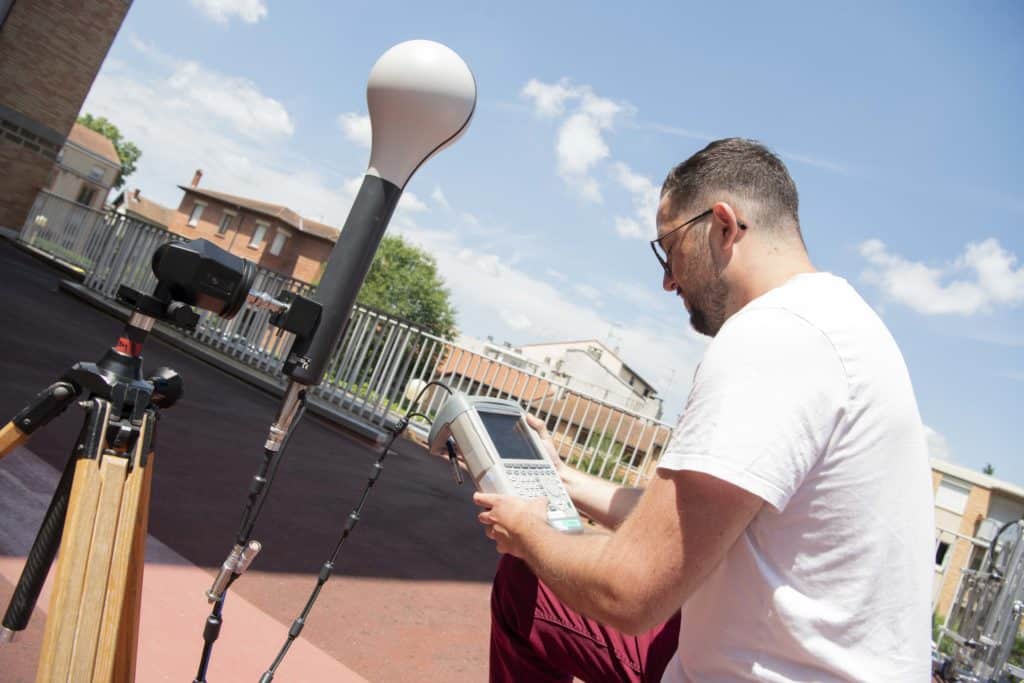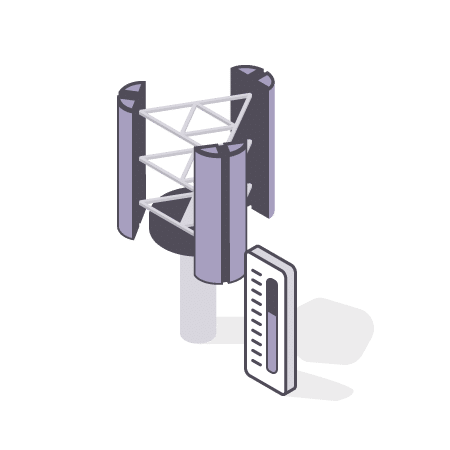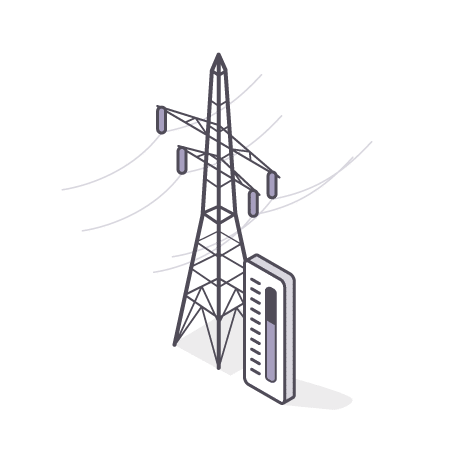Exposure measurement to electromagnetic fields
To ensure compliant premises and people safety
REGULATORY MEASUREMENTS
Why do you need to take measurements?
Measurements are essential to understand the real levels of exposure we face in different environments, such as residential areas, workplaces and schools. The reports submitted provide the relevant information to take the necessary action to ensure compliance.
Preventing potential health effects, ensuring regulatory compliance, assessing the environment and supporting research into ‘electromagnetic waves and health’ are all reasons for using measurement solutions. That’s why, for over 10 years, we have made this specific expertise our core business.
Compliance with regulations
Measurements are necessary to check that levels of exposure to electromagnetic waves are within the regulatory limits set by the competent authorities. Precise identification of the source exceedance enables necessary action to be taken.
Employees at particular risk
Pregnant women are among the employees at particular risk. Regulations protect them with exposure limits to electromagnetic fields that are 5 times lower than those applied to other workers. On-site measurements are used to establish zoning around equipment and workstations to guarantee their health and safety.
Environmental health
Measuring electromagnetic fields on site is the only way to get an accurate picture of the deployment impact of radiating infrastructures on our direct environment, in the same way as measuring air quality or noise.
FOR WHO ?
All concerned
Regulatory authorities, telecom operators, local authorities, healthcare professionals, researchers and scientists, HSE managers, environmental health experts, private individuals, etc. we are all concerned by measurements of exposure to electromagnetic waves.
for
local authorities
For elected representatives wishing to implement an environmental health policy, plan urban development safely, respond to residents’ concerns and educate the public about risks and good practice, the measures provide essential information for drawing up relevant action plans.
for
individuals
If you would like to gain a better understanding of the electromagnetic environment in your home, these measurements will enable you to assess your home’s compliance with regulatory limits.
for
industries
If you want to comply with regulations, ensure the safety of your workers, guarantee the reliability of your equipment, carry out research and development, or manage your brand image, measurements are an essential step.
for
offices
If you want to protect the health and well-being of your employees, comply with regulations, strengthen your social responsibility and better respond to the concerns of your workforce, measures are essential to create a safe and healthy working environment.
for
telecoms infrastructures
If you want to comply with regulations, assess your environmental impact, plan and optimise your network, ensure the safety of your workers and respond to the concerns of your stakeholders, these measures will benefit your business.
for
real estate parks
For you who want to provide information to your occupants and manage their concerns, enhance the value of your property assets, comply with regulations and promote your social responsibility, measurements are synonymous with transparency and security.
REGULATORY MEASUREMENTS
Our measurements solutions in detail
Our Cofrac-accredited laboratory (Cofrac tests accreditation no. 1-5014, scope available at www.cofrac.fr) carries out all types of measurements to monitor the electromagnetic exposure of people in the home, on business sites or in places open to the public. In particular, we offer the following measurement solutions:


Radio frequency measurements
We are accredited to carry out measurements in accordance with the ANFR/DR protocol. This protocol is used to assess the compliance of sites with regard to fixed radio stations such as base stations. After mapping the site (case A), we carry out a detailed analysis (case B) at the point of maximum exposure to determine the various contributors to the total field strength.

Workplace measurements
Our research and engineering units develop methods tailored to workplace monitoring, whether in the tertiary sector, industry or even hospitals. These include measurements near welding stations, MRI machines, indoor telephone antennas and electrical installations.

Low-frequency waves measurements
We are accredited to carry out measurements in accordance with the UTE - C99 132 protocol for monitoring the levels of magnetic fields radiated by electricity transmission infrastructures. The protocol calls for mapping to be carried out in the vicinity of transmitting infrastructures, and also defines the methods for monitoring in the vicinity of power lines, making it possible to determine how the field decreases with distance.

Specific measurements
Our research and engineering units develop measurement methods specific to very particular needs, such as research programmes. For example, we work with stakeholders in the field of electromagnetic waves and health to propose measurements in order to characterise exposure under real conditions of use.
We can help you
"*" indicates required fields
UNDERSTAND EVERYTHING
FAQs
Here you will find answers to frequently asked questions regarding electromagnetic wave exposure measurements.
- Choice of measuring point:
You can select the measuring point. If you don’t make a choice, the technician will choose the location with the highest exposure. For this purpose, he moves a probe at a height of 1.5 m from the ground to different locations of the locations to be measured. In the case of communicating objects, the measurement is generally carried out in front of it.
- In the case of an overall assessment (Case A):
In order to obtain an average exposure value, the exposure level is measured in electric field at three different heights. These measurements are carried out for a period of six minutes for each height, corresponding to the height of a person. The exposure level is expressed in Volts per meter (V/m).
- In the case of a detailed evaluation (Case B):
For the detailed evaluation, the technician uses a spectrum analyzer and three different probes. This makes it possible to cover all types of wave emissions. On the other hand, only one probe is necessary for the overall evaluation.
- In the case of a smart meter: The level of exposure is measured at a single point, taking into account both the electric field and the magnetic field, and using the maximum values. The electric field is expressed in Volt per metre (V/m), while the magnetic field is expressed in Tesla (T). The technician uses a spectrum analyser and two probes to take these measurements.
The technician measures all the emissions from the equipment used and surrounding areas, such as FM radio, television, mobile phones, WiFi, microwave ovens, base stations, etc. If the level measured is less than 6 V/m, the measurement is concluded. If the level measured is equal to or greater than 6 V/m, this indicates a level that is substantially higher than the levels usually measured, known as an “atypical point”. However, it is still below the regulatory limit values, which are between 28 and 87 V/m. In this case, the technician will carry out a detailed control measurement, in accordance with the instructions provided in the ANFR protocol.
The purpose of detailed monitoring is to assess the contribution of each transmitter (television, FM radio, mobile telephony, WiFi) to overall exposure. If overall exposure exceeds 6 V/m, which corresponds to an atypical point, the detailed assessment identifies the source on which priority action should be taken to reduce exposure.
These measurement requests generally relate to the Linky meter. According to the ANFR protocol, the measurement is carried out at a distance of 20 cm from the meter, except in cases where its position does not allow it or if you have another preference in this respect.
The measurement report is essential for checking that the measurement site complies with the regulations in force. An e-mail will be sent to the applicant and to the French National Frequencies Agency (ANFR) with instructions on how to download the full measurement report. The results summary sheet will be sent to the town hall or authorised body that submitted the request (if different from the town hall), to the occupant and to the owner of the property.
The public report, excluding any personal data about you, will be available to download from the ANFR website: www.cartoradio.fr. This platform can also be used to locate relay antennas in France and access 60,000 exposure measurements.
Atypical points are defined as locations where the level of exposure to electromagnetic fields significantly exceeds the level generally observed nationwide. ANFR has established an overall exposure criterion greater than or equal to 6 V/m, based on the results of measurements carried out in accordance with its measurement protocol. Atypical points may be located in residential accommodation or places accessible to the public.
Where these levels are exceeded, operators who have received agreements or advice from ANFR are required, as far as it is technically possible, to take measures to reduce the level of fields received in these locations, while guaranteeing the coverage and quality of services provided.
The ANFR (French National Frequencies Agency) is responsible for ensuring compliance with the limit values for public exposure to electromagnetic waves, as set out in the decree no. 2002-775 of the 3rd of May 2002. As part of this mission, it draws up a protocol for measuring exposure and updates it in line with technological advances.
This protocol, which is referenced in the Journal Officiel, serves as a reference for accredited laboratories carrying out measurements in the field. Its aim is to ensure that reliable and reproducible results are obtained, thereby guaranteeing the accuracy of exposure measurements.
The French government has set up a national information system on electromagnetic fields emitted by high-voltage lines in 2011, involving an extensive measurement programme starting in 2013. More than 2,000 high-voltage lines across the metropolitan territory, with at least one urbanised area, were taken into account, and more than 5,000 measurement points were carried out until 2018 by independent laboratories approved by COFRAC in accordance with French standard UTE C99-132. The results are available to the public on the https://www.clefdeschamps.info/ website.
At the same time, RTE and the Association des Maires de France (AMF) signed an agreement covering the 18,000 municipalities crossed by high-voltage lines, committing RTE to responding to requests for information from town halls about the electromagnetic fields emitted by these lines. The process begins with the provision of an information brochure on the fields and the survey and measurement system offered to town halls. Requests for information are dealt with individually, with the possibility of carrying out specific measurements on request to better meet the needs of town halls.
The mayor of each municipality contacts RTE, and each request is assessed jointly with the municipality to determine the most appropriate response. RTE can take readings directly and answer residents’ questions, or commission an independent laboratory to take measurements in accordance with a standardised protocol. If the local authority wishes, RTE can cover the cost of this service. In all cases, the commissioned laboratory coordinates the measurements with the local council and sends it the final report.
Find out more, download the brochure for mayors.
Electromagnetic fields vary considerably according to their frequency, which influences their characteristics and behaviour. It is therefore inappropriate to directly compare fields of very different frequencies, such as those from high-voltage lines and those from telecommunications equipment.
